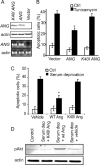Control of motoneuron survival by angiogenin
- PMID: 19109488
- PMCID: PMC6671464
- DOI: 10.1523/JNEUROSCI.3399-08.2008
Control of motoneuron survival by angiogenin
Erratum in
-
Erratum: Kieran et al., "Control of Motoneuron Survival by Angiogenin".J Neurosci. 2021 Sep 1;41(35):7509-7510. doi: 10.1523/JNEUROSCI.1370-21.2021. Epub 2021 Aug 12. J Neurosci. 2021. PMID: 34385362 Free PMC article. No abstract available.
Abstract
Mutations in the hypoxia-inducible factor angiogenin (ANG) have been identified in Amyotrophic Lateral Sclerosis (ALS) patients, but the potential role of ANG in ALS pathogenesis was undetermined. Here we show that angiogenin promotes motoneuron survival both in vitro and in vivo. Angiogenin protected cultured motoneurons against excitotoxic injury in a PI-3-kinase/Akt kinase-dependent manner, whereas knock-down of angiogenin potentiated excitotoxic motoneuron death. Expression of wild-type ANG protected against endoplasmic reticulum (ER) stress-induced and trophic-factor-withdrawal-induced cell death in vitro, whereas the ALS-associated ANG mutant K40I exerted no protective activity and failed to activate Akt-1. In SOD1(G93A) mice angiogenin delivery increased lifespan and motoneuron survival, restored the disease-associated decrease in Akt-1 survival signaling, and reversed a pathophysiological increase in ICAM-1 expression. Our data demonstrate that angiogenin is a key factor in the control of motoneuron survival.
Figures




References
-
- Camu W, Henderson CE. Purification of embryonic rat motoneurons by panning on a monoclonal antibody to the low-affinity NGF receptor. J Neurosci Methods. 1992;44:59–70. - PubMed
-
- Cashman NR, Durham HD, Blusztajn JK, Oda K, Tabira T, Shaw IT, Dahrouge S, Antel JP. Neuroblastoma × spinal cord (NSC) hybrid cell lines resemble developing motor neurons. Dev Dyn. 1992;194:209–221. - PubMed
-
- Cleveland DW, Rothstein JD. From Charcot to Lou Gehrig: deciphering selective motor neuron death in ALS. Nat Rev Neurosci. 2001;2:806–819. - PubMed
-
- Crabtree B, Thiyagarajan N, Prior SH, Wilson P, Iyer S, Ferns T, Shapiro R, Brew K, Subramanian V, Acharya KR. Characterization of human angiogenin variants implicated in amyotrophic lateral sclerosis. Biochemistry. 2007;46:11810–11818. - PubMed
-
- Cronin S, Greenway MJ, Ennis S, Kieran D, Green A, Prehn JH, Hardiman O. Elevated serum angiogenin levels in ALS. Neurology. 2006;67:1833–1836. - PubMed
Publication types
MeSH terms
Substances
LinkOut - more resources
Full Text Sources
Other Literature Sources
Medical
Molecular Biology Databases
Research Materials
Miscellaneous
